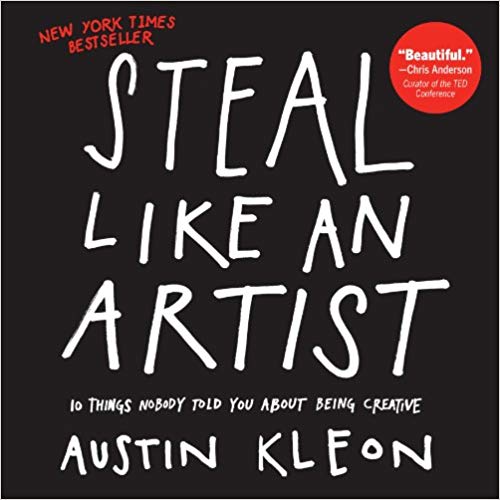Book Notes – Steal Like An Artist

1. Steal like an artist
If we’re free from the burden of trying to be completely original, we can stop trying to make something out of nothing, and we can embrace influence instead of running away from it.
The artist is a collector. Not a hoarder, mind you, there’s a difference: Hoarders collect indiscriminately, artists collect selectively. They only collect things that they really love.
Chew on one thinker – writer, activist, role model – you really love. Study everything there is to know about that thinker. Then find three people that thinker loved, and find out everything about them. Repeat this as many times as you can.
The great thing about dead or remote masters is that they can’t refuse you as an apprentice. You can learn whatever you want from them. They left their lesson plans in their work.
2. Don’t wait until you know who you are to get started
The songwriter Nick Lowe says, “You start out by rewriting your hero’s catalog.”
If you copy from one author, it’s plagiarism, but if you copy from many, it’s research.
Don’t just steal the style, steal the thinking behind the style. You don’t want to look like your heroes, you want to see like your heroes.
Internalise their way of looking at the world.
3. Write the book you want to read
- Gather the branches on your tree
- Mix & match
- Make what they would make
The best advice is not to write what you know, it’s to write what you like. Write the kind of story you like best – write the story you want to read.
4. Use your hands
In the digital age, don’t forget to use your digits!
The writer Brian Kiteley says he tries to make his workshops true to the original sense of the word: “a light, airy room full of tools and raw materials where most of the work is hands-on.”
The computer is really good for editing your ideas, and it’s really good for getting your ideas ready for publishing out into the world, but it’s not really good for generating ideas. There are too many opportunities to hit the delete key. The computer brings out the uptight perfectionist in us – we start editing ideas before we have them.
Hands first, then computer.
I have two desks in my office – one is “analog” and one is “digital.”
6. The Secret: Do good work and share it with people
You don’t put yourself online only because you have something to say – you can put yourself online to find something to say.
You don’t have to share everything – in fact, sometimes it’s much better if you don’t. Show just a little bit of what you’re working on. Share a sketch or a doodle or a snippet. Share a little glimpse of your process. Think about what you have to share that could be of some value to people. Share a handy tip you’ve discovered while working. Or a link to an interesting article. Mention a good book you’re reading.
8. Be nice. The world is a small town
Complain about the way other people make software by making software.
I recommend public fan letters. The Internet is really good for this. Write a blog post about someone’s work that you admire and link to their site. Make something and dedicate it to your hero. Answer a question they’ve asked, solve a problem for them, or improve on their work and share it online.
9. Be boring. It’s the only way to get work done
Amassing a body of work or building a career is a lot about the slow accumulation of little bits of effort over time.
10. Creativity is subtraction
You must embrace your limitations and keep moving.